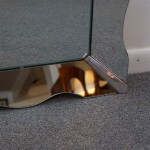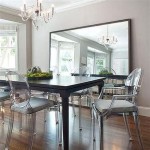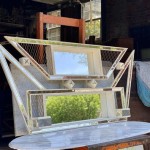The Enduring Allure of the Rococo Mirror in Gold
Rococo mirrors, particularly those finished in gold, represent a significant and visually compelling element within the broader context of 18th-century decorative arts. The Rococo period, spanning roughly from the 1730s to the 1770s, emphasized asymmetry, elegance, and ornate detailing, a stark departure from the more rigid and symmetrical Baroque style that preceded it. These mirrors, often grand in scale and meticulously crafted, were not merely functional objects for reflection but rather served as potent symbols of wealth, status, and sophisticated taste. The application of gold leaf, in particular, elevated these mirrors to the level of art, reflecting not only light but also the refined sensibilities of the era.
The Rococo style originated in France as a reaction against the formal and imposing aesthetic of Louis XIV's reign. It quickly spread throughout Europe, influencing the design of furniture, architecture, and decorative objects. The mirror, a central element in interior design from the Renaissance onward, became a prime vehicle for expressing the Rococo aesthetic. The use of gold, a precious and highly valued material, further amplified the opulence and grandeur associated with this artistic movement.
Understanding the Rococo mirror in gold requires consideration of its historical context, the materials and techniques involved in its creation, and its enduring appeal in contemporary design. These ornate mirrors offer insight into the social, economic, and artistic values of the 18th century, and they continue to be admired and sought after by collectors and design enthusiasts alike.
Key Characteristics of Rococo Mirror Design
Rococo mirrors are immediately recognizable by their distinctive features. Asymmetry is perhaps the most defining characteristic. Unlike the balanced and predictable designs of earlier periods, Rococo mirrors embrace organic forms, swirling lines, and unexpected curves. The frames are rarely symmetrical, often incorporating asymmetrical cartouches, floral motifs, and shell-like ornamentation.
Another key characteristic is the heavy use of ornamentation. Rococo mirrors are laden with intricate carvings, often depicting natural elements such as flowers, leaves, and shells. These carvings are typically three-dimensional, adding depth and texture to the frame. The use of putti (cherubic figures) is also common, adding a playful and lighthearted touch to the overall design.
Furthermore, the shape of the mirror itself is often irregular. While many Rococo mirrors feature a central rectangular or oval glass, the frame surrounding it often incorporates curves, scrolls, and projections. This creates a dynamic and visually engaging silhouette that defies simple geometric forms. The overall effect is one of movement, lightness, and elegance.
The use of giltwood (wood covered in gold leaf) is a defining element. Giltwood provides a rich, luminous finish that enhances the intricate carvings and ornamentation. The application of gold leaf required considerable skill and expertise, further demonstrating the high level of craftsmanship associated with Rococo mirrors. Different shades of gold, or even the strategic burnishing of the gold, were frequently employed to highlight specific areas and create visual contrast.
Finally, the size of Rococo mirrors often contributes to their impact. While smaller, more intimate mirrors were certainly produced, many Rococo mirrors were designed to be large and imposing, commanding attention and dominating the room. These grand mirrors were frequently placed above fireplaces or between windows, serving as focal points and reflecting light to enhance the overall ambiance of the space.
Materials and Techniques in Rococo Mirror Production
The creation of a Rococo mirror in gold was a complex and labor-intensive process, requiring the expertise of skilled artisans. The materials used were carefully selected for their quality and durability, ensuring that the finished product would last for generations.
The primary material for the mirror frame was typically wood, often a softwood such as pine or fir, which was easy to carve. The wood was first carefully shaped and then covered with a layer of gesso, a mixture of plaster of Paris, glue, and water. The gesso provided a smooth, even surface for the application of gold leaf. Multiple layers of gesso were typically applied, each layer being carefully sanded to create a flawless finish. This process was crucial for ensuring the longevity and brilliance of the gilding.
The carvings were then executed. Skilled carvers used a variety of tools to create the intricate designs, which often included floral motifs, shells, scrolls, and figural elements. The level of detail and artistry varied depending on the quality of the mirror and the skill of the carver. The carvings were deeply undercut, creating a sense of depth and dimension.
The application of gold leaf, known as gilding, was a specialized skill in itself. Thin sheets of gold leaf were carefully applied to the gessoed surface using a special adhesive called mordant. The gold leaf was then burnished to create a smooth, lustrous finish. Different techniques were used to achieve different effects, such as matte or polished gold. Sometimes, different colors of gold leaf were used to highlight specific areas of the carving.
The mirror glass itself was typically made using the blown glass process, which involved blowing a bubble of molten glass and then flattening it into a sheet. The glass was then silvered using a mercury amalgamation process, which created a reflective surface. This process was hazardous due to the toxicity of mercury, but it was the standard method for producing mirrors during the Rococo period.
Finally, the various components of the mirror were assembled. The mirror glass was carefully fitted into the frame, and any necessary repairs or adjustments were made. The finished mirror was then often treated with a protective coating to prevent tarnishing and damage.
The Enduring Appeal and Contemporary Relevance
Despite being a product of the 18th century, the Rococo mirror in gold continues to hold significant appeal in contemporary design. Its ornate detailing, elegant curves, and luxurious finish make it a statement piece that can add a touch of glamour and sophistication to any space. The use of gold, in particular, resonates with a desire for opulence and luxury, even in modern settings.
The enduring appeal of Rococo mirrors can be attributed to several factors. First, their intricate craftsmanship and artistic merit make them objects of beauty and admiration. The attention to detail and the skill required to create these mirrors are evident in every curve and carving. Second, their historical significance adds to their appeal. Rococo mirrors represent a specific period in history, a time of great artistic and cultural innovation. Owning a Rococo mirror is like owning a piece of history.
Furthermore, Rococo mirrors are versatile design elements that can be incorporated into a variety of interior styles. While they are naturally at home in traditional or period settings, they can also be used to create an eclectic and unexpected look in modern spaces. For example, a large Rococo mirror can add a touch of drama to a minimalist living room, or it can be used to create a focal point in a bedroom. The contrast between the ornate detailing of the mirror and the clean lines of modern furniture can be particularly striking.
In contemporary design, Rococo mirrors are often used as decorative accents, adding a touch of personality and character to a space. They can be hung on walls, placed above fireplaces, or used as part of a gallery wall. They can also be incorporated into furniture designs, such as consoles or dressers. Interior designers frequently use mirrors to enhance the sense of space and light in a room, and Rococo mirrors are particularly effective in this regard due to their reflective surfaces and ornate frames.
The availability of reproduction Rococo mirrors has also contributed to their enduring appeal. While antique Rococo mirrors can be expensive and difficult to find, high-quality reproductions offer a more accessible option for those who appreciate the style. These reproductions are often crafted using traditional techniques and materials, ensuring that they capture the essence of the original designs.
In conclusion, the Rococo mirror in gold remains a captivating and relevant design element, its enduring appeal rooted in its exquisite craftsmanship, historical significance, and versatility. Its presence continues to enrich and enhance interior spaces, reflecting not only images but also the enduring legacy of a remarkable artistic era.

Extra Large Decorative Gold Rococo Mirror I Passed My Decorating Phase A Few Decades Ago But C Floor Decor Living Room

Reion Gold Leaf Rococo Wall Mirror Juliettes Interiors

Ornate Antique Gilded Gold Rococo Mirror For At 1stdibs

Opulance Gold Rococo Wall Mirror

Large Gold Rococo Wall Mirror Juliettes Interiors

Extra Large Full Length Gold Rococo Dress Mirror At 1stdibs Floor

Extra Large Full Length Gold Rococo Dress Mirror Victorian Big Vintage Mirrors

Large French Rococo Louis Xv Style S And Floral Carved 65 Gold Wall Mirror For At 1stdibs

French Mirror Baroque Rococo Antique Gold

Mirror Rococo








